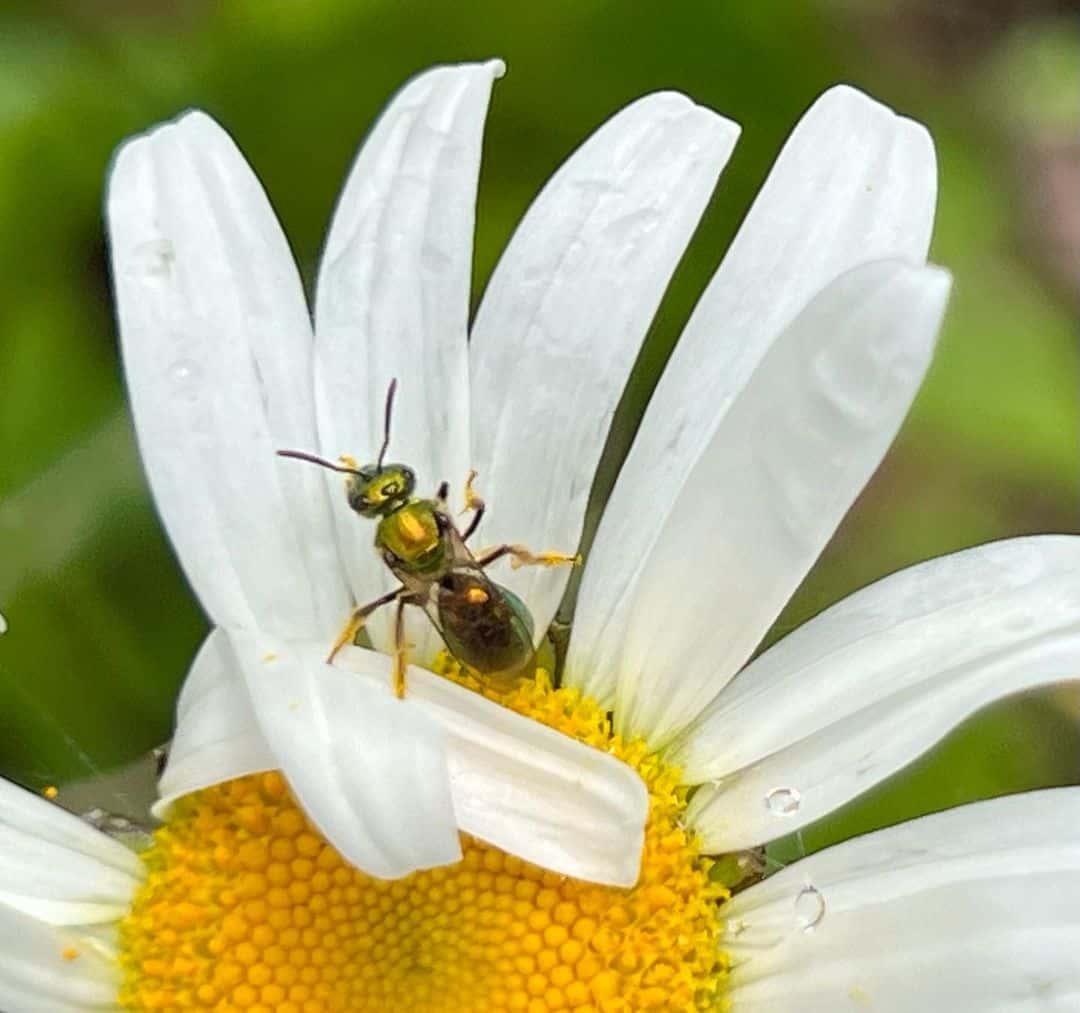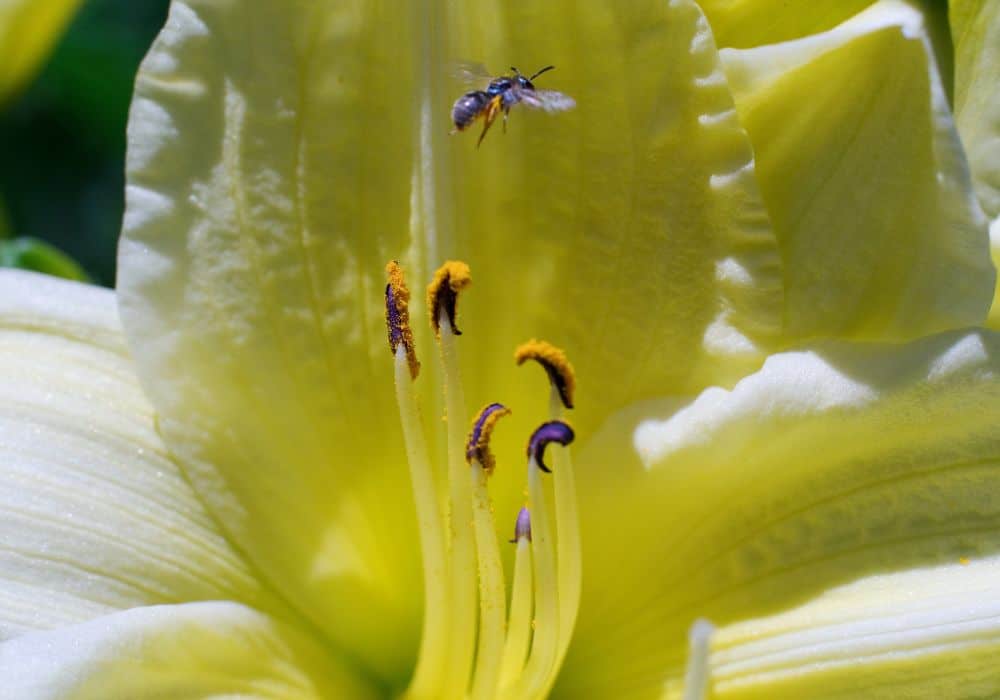Are you struggling to get rid of sweat bees? These metallic, shiny, and flying nuisances can give you a real headache! One minute you’re enjoying your barbecue, and the next, you are fighting off a stubborn bee that just will not seem to let you go!
In addition, if you are allergic to bee stings, you definitely do not want to be around bees! Although sweat bees are a bit smaller than regular bees, their sting can cause an allergic reaction!
If we are on the same page, buckle up because this article will discuss how to get rid of sweat bees!
Briefly About Sweat Bees
Before we deal with the ways of repelling, trapping, and killing sweat bees, you need to know who you are up against!
Some species of bees can have aggressive and unpredictable behavior, which makes it harder for us to kick them out or eliminate them without getting stung! Luckily that is not the case with sweat bees.
Unlike hornets and wasps, sweat bees are not aggressive and will only attack if they are in danger. Compared to other bees, they are smaller, and their sting is not as painful, although if you are allergic, you need medical assistance nonetheless.
What do Sweat Bees look like?
As mentioned, they have greenish, metallic black bodies, making them very different from regular yellow jacket bees, so people do not associate them with bees. They belong to the Halictidae, which is the largest family of bees with over 4,500 species.
They are called sweat bees (Halictid) because they are attracted to human sweat. Their size varies between 5 to 11 mm or ¼–¾ inch.
Interestingly, their diet calls for salt, commonly found in our sweat, so they use it for a more active lifestyle and to supplement their diet.
Like other bees, sweat bees feed on pollen and nectar of flowers, but that does not mean they do not need to supplement their diet with some salt and moisture! So, when you see a sweat bee landing on your arm, it is probably looking for some sweat rather than attacking you!
Where do Sweat Bees live?
Sweat bees can be found on every continent except Antarctica. Their natural habitat includes grasslands, fields, meadows, gardens, roadsides, and basically any open area covered with flowers, including tropical ones.
These bees nest in the ground and live in swarms. They make their nest by digging a small burrow and laying their eggs, which will go through three other stages: larvae, pupae, and adults.
How to Get Rid Of Sweat Bees: Fast And Effective Methods
1. Sweat Bee Trap
One of the easiest ways to eliminate sweat bees is to use bee traps! Duh! They are very affordable and available; you can buy them at Home Depot. Regardless of the brand and the manufacturers, most (more or less) bee traps work on the same principle.
Whether made of plastic or wood, the traps mimic the appearance of their nest with strategically placed holes. When they enter the ‘fake nest,’ they realize that the only light source is at the end of the container, so they enter it.
Once they enter it, they will not be able to leave. People often use sweeteners to attract the bees. You may use the traps if you have a couple of sweat bees here and there. You can also make DIY bee traps with a plastic bottle, staples, honey, or soda.
But if you are dealing with an infestation, it will not be that effective because the traps will not prevent them from laying eggs or the next generations of bees.
2. Natural Remedies: Essential Oil
Nature is magnificent, and most cures and solutions to our problems (but not all) can be found there! Nature has blessed us with numerous essential oils, which are natural deterrents for not only sweat bees but several other pests, including rats and ants.
The most hailed and effective essential oil is peppermint oil, although you can try it with eucalyptus, citronella, or clove oil! They hate the smell of mint and citrus, so they will try to avoid it!
You can easily make a spray that you can use on your skin and the areas usually targeted by sweat bees! Just take a spray bottle, fill it with water, and add several drops of peppermint oil or any other! Apply it to your exposed skin and enjoy your day!
Alternatively, you can make an essential oil burner or add essential oil to your normal candles. Just add a drop or two, depending on the size of the candle, to the top of it, and avoid the wick!
3. Store-bought Repellents
Considering that a lot of people do not enjoy the company of bees, there are plenty of bee sprays and repellents on the market. Although you can make a repellent at home using the essential oils mentioned above, some people want a quicker and simpler solution.
Some popular bee repellents include Donaldson Farms Carpenter Bee Repellent Spray, No-See-Ums Natural Repellent Spray by Best Bee Brothers, and Blythewood Bee Company Honey-B-Gone Honeybee Repellent.
The repellent does not have to come in the form of a spray; you can also use Cutter Citro Guard Candle, which is non-toxic and effective.
4. Did Someone Say Mothballs?
Did you know that bees and hornets hate mothballs? In case you are not familiar with mothballs or you have been living under a rock, mothballs, just like the name implies, are small balls coated with chemical pesticides and deodorants.
They are used to kill moths, silverfish, and other pests that like to damage our clothing. Mothballs are a form of insecticide, and they can also be used to deter sweat bees due to their distinctively pungent smell.
Considering that mothballs are toxic to humans and pets, when using them, always place them in an air-tight container or plastic bag along with your clothes.
However, when it comes to deterring bees, mothballs are excellent if you notice a bee hive near your house or your garage and want to get rid of it. In such a situation, you can place the mothballs near the hive, and when the smell reaches them, they will fly away.
5. Repelling Strips

Image Credit: margiepatlak
Repelling strips are a great way to deal with sweat bees; you can use them in enclosed spaces. Most manufacturers of repelling strips use a toxic chemical called dichlorvos, which deters bees by emitting a deep-penetrating vapor.
The most popular ones are NO-PEST STRIP, which can last up to 4 months. Do not worry; the vapor is odorless and clean to us, so you won’t have to suffer with the bees as well! These strips also deter other insects, such as flies, moths, and crawling bugs.
6. Bee Spray
Most of the solutions mentioned above for eliminating sweat bees are recommended indoors, but bee spray can be used even outdoors, although the effects are limited.
Obviously, it is harder to control and deter bees outside with these methods that use certain odors and smells to get rid of pests and insects.
If you noticed a couple of bees you suspect might try to nest near your property, you can make a DIY bee spray using products you probably have in the house at the moment.
Here is how you can make it! You will need dish soap, water, and a spray bottle. Then place 1 part dish soap with 4 part water in the spray bottle and spray the bees with the solution. This DIY bee spray is pretty effective, and unlike other insecticides, it will not leave any harmful residue.
If you want to make this solution even more potent, instead of regular soap, add mint soap!
Important note: If you are dealing with honey bee or sweat bee infestation, it is recommended that you call professionals or pest control to get rid of them.
Why? Generally, bees are highly crucial for the ecosystem as they are pollinators, ensuring that our garden and wildflowers bloom. They pollinate a number of other important crops, such as sunflowers, stone fruits, alfalfa, and many others.
Therefore, killing them should be considered a last resort rather than the first option.
7. Good Hygiene and Protective Clothing
As mentioned, sweat bees are attracted to sweat, which is why they hover around us. A great way to stop them from getting near you is to take a shower before going into the garden or outdoors.
However, that is not always possible, especially for farmers who spend hours working in the field doing heavy physical labor and in hot temperatures. In that case, you may wear protective clothing, including pants and a T-shirt with long sleeves.
That way, there will be no exposed skin for them to land on!
Conclusion
There are numerous ways to get rid of sweat bees! Compared to other species of bees, consider yourself lucky if you are dealing with sweat bees because they are not aggressive and rarely sting!
So, let’s go through the solutions and methods you can use: bee traps, bee repellents, bee spray, repelling strips, mothballs, and essential oils. You can also undertake good hygiene and wear protective clothing to avoid them landing on you!
Have you ever dealt with a sweat bee infestation? If you have any questions or have tried some of our methods, do forget to use the comment section to share your experience or to ask a question!
